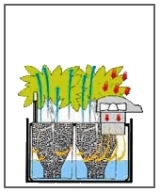 With the rapid increase in the “Green” movement and the push for more energy efficient homes spray polyurethane foam SPF insulation is growing substantially. As with most new building products the industry has had its own set of unique challenges that include the recognized need for training and certification for installers. Along with the recognized need for training are the results of inadequate applicator training, nuisance odors and occupant sensitivity. These occupant related complaints have led to a rise in SPF insulation investigations by many who have little understanding of SPF insulation and how it can alter the indoor environment even when correctly installed.
With the rapid increase in the “Green” movement and the push for more energy efficient homes spray polyurethane foam SPF insulation is growing substantially. As with most new building products the industry has had its own set of unique challenges that include the recognized need for training and certification for installers. Along with the recognized need for training are the results of inadequate applicator training, nuisance odors and occupant sensitivity. These occupant related complaints have led to a rise in SPF insulation investigations by many who have little understanding of SPF insulation and how it can alter the indoor environment even when correctly installed.
When it comes to the investigation of nuisance odors associated with the application of spray polyurethane foam SPF insulation, I’ve found that most of the investigations typically involve little more than varied attempts at trying to chemically associate the odor with the off-gassing of the SPF.
I’ve been assessing spray polyurethane foam insulation SPF for several years on too many properties to list. I’ve assessed a dozen or so product lines both closed and open cell for manufactures, builders, homeowners, and applicators. The properties ranged from universities, community centers, offices, homes, both new construction and retrofit applications.
In my experience, SPF investigations can be categorized in three distinct categories. The first two seem to be the primary areas of SPFI investigations. The first category is simply miss-applied SPF, the second is presence of pre-existing or recently introduced contaminants and the third would be occupant exposure and sensitization during SPF application.
By using these three assessment categories, I have had great luck in identifying the catalyst of the odor and associated complaint. It has also helped raise awareness that it’s not always the SPF.
The first category – Category 1 Miss-applied SPF Insulation category
These nuisance odors are directly associated with incorrectly applied SPF insulation and can be addressed by either correcting the areas of miss-applied foam or by removing and re-insulating the areas. Miss-Applied includes improper ventilation during the application, incomplete application, off ratio application, and also includes the SPF in direct contact with recessed can lights in the attic, keyless light fixtures bulbs, dryer vents, and/or chimney flues, all of which can heat the SPF and cause a tremendous amount of chemical odors.
Category 1 is relatively cut and dry and requires the onsite inspection of the SPF and the collection of no air samples. The inspection of the foam and the determination of correct and complete installation is a critical first step.
I‘ve been on SPF insulation investigations where other Indoor Environmental Professionals (IEP’s) who were hired to assess the SPF insulation never looked at the SPF insulation. Most have no knowledge of how to assess the correct or complete installation of the SPF insulation. Most IEP’s show up with all manner of air sampling equipment and begin and end their investigation with the collection of air samples intending to identify the chemical signature of miss-applied SPF insulation. But that’s just not going to happen.
For all who want to conduct SPF insulation inspections, start with understanding what correct and complete installation is according to the manufacturer who produced the foam you are inspecting.
Below is an example of a home with retro-fit SPF insulation installed in the attic. The homeowners hired an IEP to help establish and/or confirm that the SPF insulation was making them sick. The home was traditionally ventilated with a large rear lanai. As with typical SPF insulation landscape fabric was used to separate the lanai attic from the sealed SPF insulation attic. However, the large Lanai attic space was not properly ventilated as shown in Diagram 1.
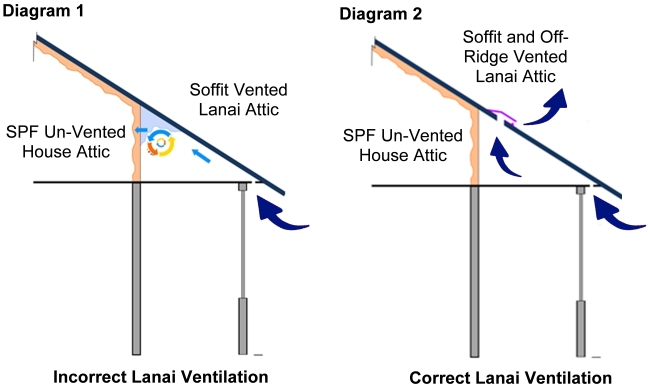
The lanai had soffit vents and no off ridge vents hence the incomplete attic ventilation. The outdoor air pressure (wind) was moving the hot humid Florida air into the attic and into the sealed SPF insulation attic through the landscape fabric and SPF insulation as shown in Diagram 3. The moisture was supporting microbial growth that was the actual odor identified within the home. The correction was to first relieve the lanai attic pressure by installing an off ridge vent as shown in Diagram 2 and then by removing and replacing the mold damaged SPF insulation.
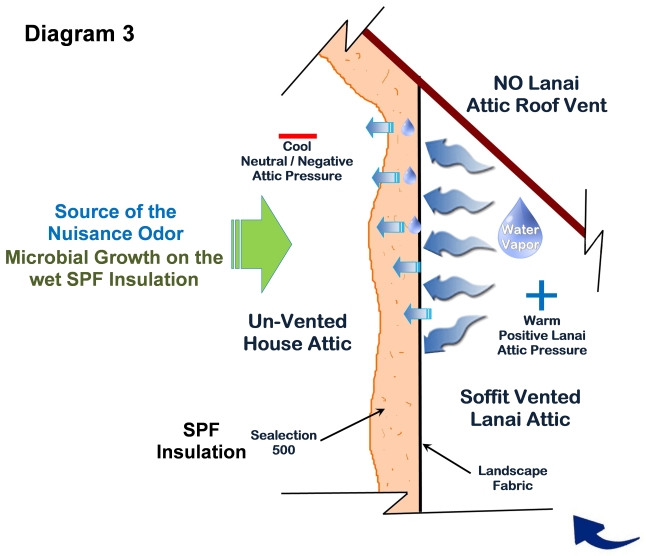
Unfortunately, thousands of dollars were spent on the hunt for the infamous miss-applied chemical signature of the off-gassing SPF insulation. Of course to no avail. This is just one example of the easily overlooked yet painfully obvious issues with incomplete or incorrect SPF insulation.
The second category – Category 2 pre-existing or recently introduced contributors
This category cannot be stress enough to the professionals that are investigating SPFI. This category runs the gamut and can include some rather odd contributors to occupant discomfort and nuisance odors that become much more concentrated when the SPFI is installed. These include the HVAC system, air exchange rate, storage of materials in the now sealed space, insect and or rodent activity, routine pest control applications, the previous insulation condition and material, proper ducting of kitchen and bath fans. The possibilities are endless and all must be considered. Remember that what has accumulated in the attic is now semi-conditioned air that is shared with the attic and living space of the home.
For example if the home is a 60 year old ranch that had open cell SPFI installed at the roof sheathing and the attic was not cleaned to help save a few bucks, the bath fans are ducted to the attic space, and the home once had a rodent issue that was treated with poisons. Well to say the least you have a huge list of contributors to occupant discomfort and nuisance odors. Most of the SPF insulation investigations I am called in to review all of these issues were overlooked simply because of the recent application of SPFI.
It’s not necessarily the SPF insulation that is producing the odor or contaminate that is causing occupant discomfort but the SPF insulation is what eliminated the natural ventilation of the attic which prevented the odors and contaminants from entering the home. The SPF insulation has now trapped the odors and contaminants within the semi-conditioned space.
In this case, the home also had no outdoor air and the home was accumulating VOC’s from daily use products.
The home was blower-door tested and didn’t even come close to the minimum ASHRAE air exchange rate. That attic air is now a part of the occupied space as semi-conditioned space and has 60 years of accumulated who knows what. Easily it could include the accumulation of dust, debris, fiberglass, rodent and insect activity, prior application of pesticides, maybe even vermiculite.
This is a huge aspect of an SPF insulation investigation that I find all too often overlooked. As a professional investigating SPF insulation you have to ask questions beyond the obvious who was the demon SPF insulation manufacturer.
You have to ask relevant questions such as;
- “What is the condition of the new semi-conditioned space?”
- “What have the occupants been sealed in with?”
- “How is the air exchange rate being met?”
- “How is the semi-conditioned space actually being semi-conditioned?”
Sometimes it’s best to keep it simple, particles, pathway, and pressure. Remember to keep an opened mind; it’s not always the SPF insulation.
On a retrofit SPF insulation investigation where there was an odor described as rotten eggs or sulfur the home owner hired an IEP to help establish that the SPF insulation was making them sick. The IEP’s hired to find the odor focused on TO-15 sample collection throughout the home. They were confident they identified the miss-applied SPF insulation chemical signature. Not quite. Just under $5,000 later it was determined that the samples identified a chemical cocktail that could have been the result of just about everything used within the home over the last year since the SPF insulation was applied. With no outdoor air supply and poor ventilation the VOC’s created within the home stayed in the home. What the IEP’s didn’t notice was a failed air admittance valve in the attic over the area where the odor was the strongest. At a cost of twenty bucks for a new air admittance valve the odor was eliminated.
On a new construction SPF insulation investigation, the IEP’s hired to establish that the SPF insulation was making the homeowners sick once again set up the VOC sample collection center and collected four TO-15 8 hour summa canisters and 8 sorbent tubes from a single story 2,200 square foot home.
The homeowners reported that after about a year the home began to make them feel worse when home than when away. The culprit in their mind was the SPF insulation. When I asked them how they came to that conclusion they said Google. They then hire an IEP to help them prove to the builder that the SPF insulation was making them sick.
As the IEP was setting up their summa canisters, I began my investigation that started with the condition and settings of the homes ventilation system. I knew the home had outdoor air supply. I simply wanted to determine the thermostat and Aprilaire settings and establish the amount of outdoor air being supplied to the home. As shown in the photo the Aprilaire ventilation controller was set to “Off”.
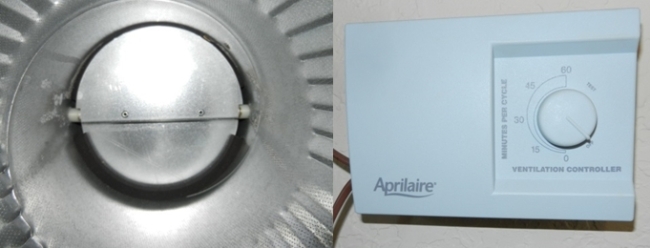
When the 8 hour sampling period was over and the IEP was collecting their equipment I cranked up the AC and opened the Aprilaire ventilator to 30 minutes per cycle. During the sampling period of 8 hours the carbon dioxide levels were measured above 2000 ppm and the tVOC’s were measured at a mere 700 to 800 ppb. After 1 hour of proper ventilation the carbon dioxide and tVOC levels were reduced by more than 50%. Amazingly the issue proved to be accumulation and not production of VOC’s. Once again a complete investigation identified an issue with the ventilation that was misdiagnosed as SPF insulation.
On another SPF insulation investigation were the homeowner had spent thousands on sampling with an IEP who felt he had established the connection between the SPF and the occupant symptoms. Again review by the PhD’s and chemist found no such connection that could be corroborated. However the interview found that the homeowner was in the second floor master bedroom during the application of the SPF insulation. The access to the attic was in the master closet, nice. The applicator didn’t want to use landscape fabric to separate the large covered second story balcony just outside of the master bedroom so the applicator just applied the SPF insulation to the ceiling of the balcony.
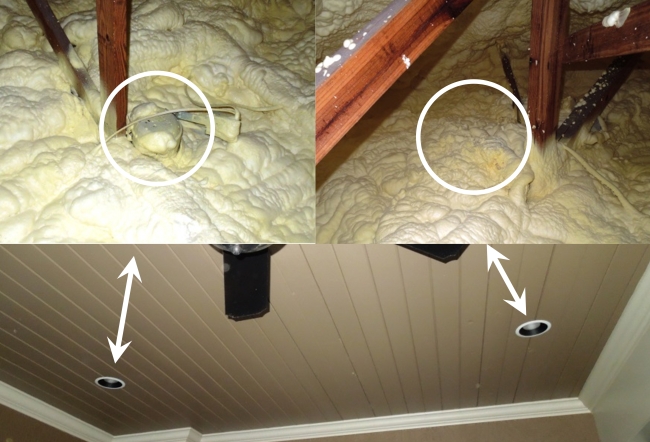
The photos above show two of the nine recessed can light fixtures that were covered in the foam from completely covered to just shy of completely covered. The homeowner liked to sit outside in the evening and look out over the lake. However, he reported that he could no longer spend the evenings on his beloved balcony because he was so sensitive to the SPF insulation. Yes he had become sensitized to the SPF insulation because he was in the home during the application but the trigger or catalyst to the odor was the heating of the SPF insulation just outside his master bedroom and just above his beloved balcony each time he turned on the balcony lights.
Sometimes as IEP’s we are hired to provide a very specific service. I’ll use mold as an example. When some IEP’s are hired to provide a mold inspection they often become far too focused on looking for one potential contributor and often overlook the many other and often obvious contributors. Samples for mold spores are collected and moisture is hunted with a vengeance but not much else is looked at or investigated. SPF insulation investigations are the same. Are we hired to help the homeowner identify what in their home may be contributing to their symptoms or are we there to prove their hypothesis that it is or isn’t mold or SPF insulation.
IEP’s often go in with blinders on and lose focus on the true intent of the investigation which in my opinion should be “What is contributing to occupant discomfort and complaint?” The IEP should approach the home as a system and be open to all potential contributors to occupant complaint. The chief characteristic that distinguishes the scientific method of investigation from other methods of investigation is that scientists seek to let reality speak for itself, supporting a theory when a theory’s predictions are confirmed and challenging a theory when its predictions prove false. Scientific investigation is generally intended to be as objective as possible in order to reduce biased interpretations of results. This is often overlooked when the IEP conducts an investigation focused on making the evidence support their hypothesis without objective challenge.
IEP’s must remember that while the SPF insulation may be the issue unless you can say there are no other issues within the home you have not completed your investigation you have just begun.
The third category – Category 3 Sensitization due to exposure
This category includes all occupants who have become sensitized or allergic to the odors given off from SPFI. With sensitization occupants have either re-entered the property shortly after the foam is applied, well before the manufacturer recommended re-occupancy time of 24 to 48 hours while the SPF insulation is still curing and off-gassing, or in the most severe cases of occupant sensitivity the exposure was actually took place during the application of the SPF insulation.
I had one case where the sensitized occupant was also the general contractor that built the home. During the interview with the owner builder, I asked what he knew as a builder about the SPF insulation. He admitted to not knowing anything until he began to react to the SPF insulation in his home. I asked if he had the MSDS to review and he informed me that he did not. Interesting, I asked if he maintained all of the building material MDS onsite. He happily sad no that’s up to the subcontractors, interesting.
I then asked him if he was curious as to how the SPF insulation was applied and he of course told me that he was very curious. He told me that he was in the attic while it was being applied. Incredible right, you can’t make this up.
I asked if he thought it was odd that the applicator was in full protective equipment with supplied air and he was just watching in street clothes. I also asked if the contractor told him that he shouldn’t be watching without personal protective equipment. He told me that the contractor told him that he shouldn’t be up there when it was being applied but it was his house and he was the builder so he was going to do what he wanted. I asked how long he was up there and he said about 30 minutes and then he began to get a huge headache. Unbelievable, he was incredibly sensitized to the foam and no amount of miss-applied SPF insulation removal was going to provide him any relief.
Sensitization of the occupants can be a result of many issues such as occupants that don’t want to spend the money for a hotel stay, early re-entry or occupancy, the curious application observer, to the painfully stupid like the builder above. However occupant sensitization can also be the result of the lack of proper ventilation during the application. Venting of the off-gassing of the SPF insulation during application is critical and often not conducted at all. In all cases of occupant sensitization that I have been involved with the SPF insulation application was not properly vented to the exterior which created a substantial accumulation of the off-gassing chemicals within the property. These trapped volatile organic chemicals VOC’s are what sensitizes the occupants who have either re-occupied too early or were present during the SPFI application.
Sensitization occurs when the occupants are overexposed to the trapped volatile organic chemicals VOC’s and become sensitized. From that point on, any exposure to even a minute amount of the chemical causes a reaction. The process of sensitization can make a home unlivable for people who become sensitized.
Homes that have improper ventilation during the application process of the SPF insulation are also included in the miss-applied category and almost always have identified areas of miss-applied SPF insulation (SPFI).
This category is unique in that any attempt at reducing the occupant’s exposure to the SPF insulation that they are now sensitized to may not be of any relief. I have had no luck in providing sensitized occupants relief from the home they are now sensitive to. I have been involved in everything from the introduction of outdoor air through a pre-filter and dehumidifier to control the temperature, humidity, particles, path, and pressure to full removal of the SPF insulation. Unfortunately that bell can’t be un-rung.
Steps in the Right Direction
SPFA’s The Spray Polyurethane Foam Professional Certification Program (“SPFA PCP”) launched at the SprayFoam 2013 Convention & Expo
To become certified under SPFA’s new program, you must pass the exam and meet the criteria for any level of Certification you would like to achieve. It is a progressive program with each level based on the candidate passing the exam for the previous level. In other words, EVERYONE must begin with SPF Assistant criteria. If your ultimate goal is to be a Certified Project Manager, you must meet the requirements for Assistant, then Installer, then Master Installer, then Project Manager to become a Certified SPF Project Manager. http://www.sprayfoam.org/
Connecticut House Bill No. 5908; An act requiring safety and certification standards for the spray foam insulation industry
ASTM WK30960 is intended to establish safe re-entry times for occupants following spray polyurethane foam insulation application.
ASTM WK30960 – New Practice for Spraying, Sampling, and Packaging Spray Polyurethane Foam (SPF) Insulation Samples for Environmental Chamber Emissions Testing
The CAN/ULC S705.1 National Standard requires that the spray polyurethane foam material be installed in accordance with the CAN/ULC S705.2 standard for Thermal insulation – Spray applied rigid polyurethane foam, medium density – Application.
The CAN/ULC S705.2 Application Standard lists a number of requirements for the manufacturer (seller of the two liquid components), the contractor (the corporation who has the contract to perform the installation) and the installer (the worker who actually sprays the components to form spray polyurethane foam on the job site).
The CAN/ULC S705.2 Application Standard sets forth requirements for environmental conditions suitable for spraying, substrate requirements, installation requirements, daily testing of the installed products and documentation requirements.
The Licensed Contractor is required to use applicators that are trained and certified under the SPF Quality Assurance Program used by CUFCA. Each installer is issued a plastic photo-identification card every July 1. The installer is required to carry this card with him during the complete installation period.
John P. Lapotaire, CIEC
Certified Indoor Environmental Consultant
Indoor Air Quality Solutions, IAQS
Microshield Environmental Services, LLC
Certification by American Council for Accredited Certification ACAC CIEC #0711048
Council-certified Environmental Thermography Consultant ACAC CETC #1005013
Accreditation by Council for Engineering and Scientific Specialty Boards (CESB)
Florida State License Mold Assessor MRSA #4
www.FloridaIAQ.com
http://www.microshield-es.com/sprayfoam.html
http://www.microshield-es.com/moldinspectiontesting.html
www.microshield-es.com

Share this with the #IAQS:
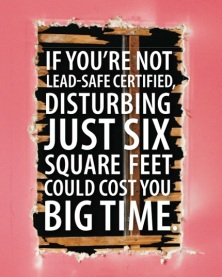 EPA‘s RRP Rule requires anyone (remodeling, renovation and painting contractors and most other trades) who works in pre-1978 housing for compensation and who might disturb painted surfaces to become an EPA Certified Renovator by taking a “Lead Safe Work Practices” RRP class from an EPA accredited training provider.
EPA‘s RRP Rule requires anyone (remodeling, renovation and painting contractors and most other trades) who works in pre-1978 housing for compensation and who might disturb painted surfaces to become an EPA Certified Renovator by taking a “Lead Safe Work Practices” RRP class from an EPA accredited training provider.



 Posted by John P. Lapotaire, CIEC
Posted by John P. Lapotaire, CIEC 
